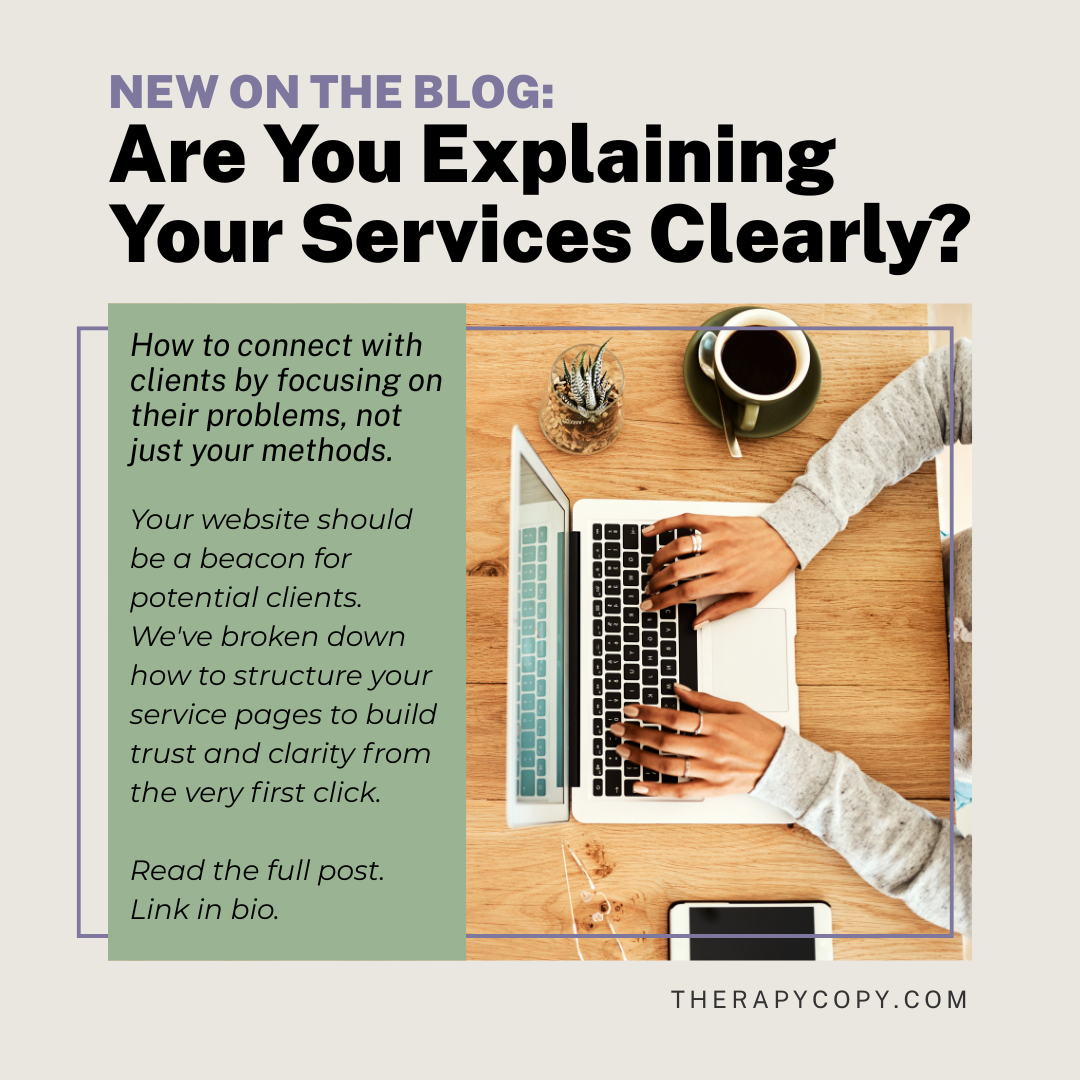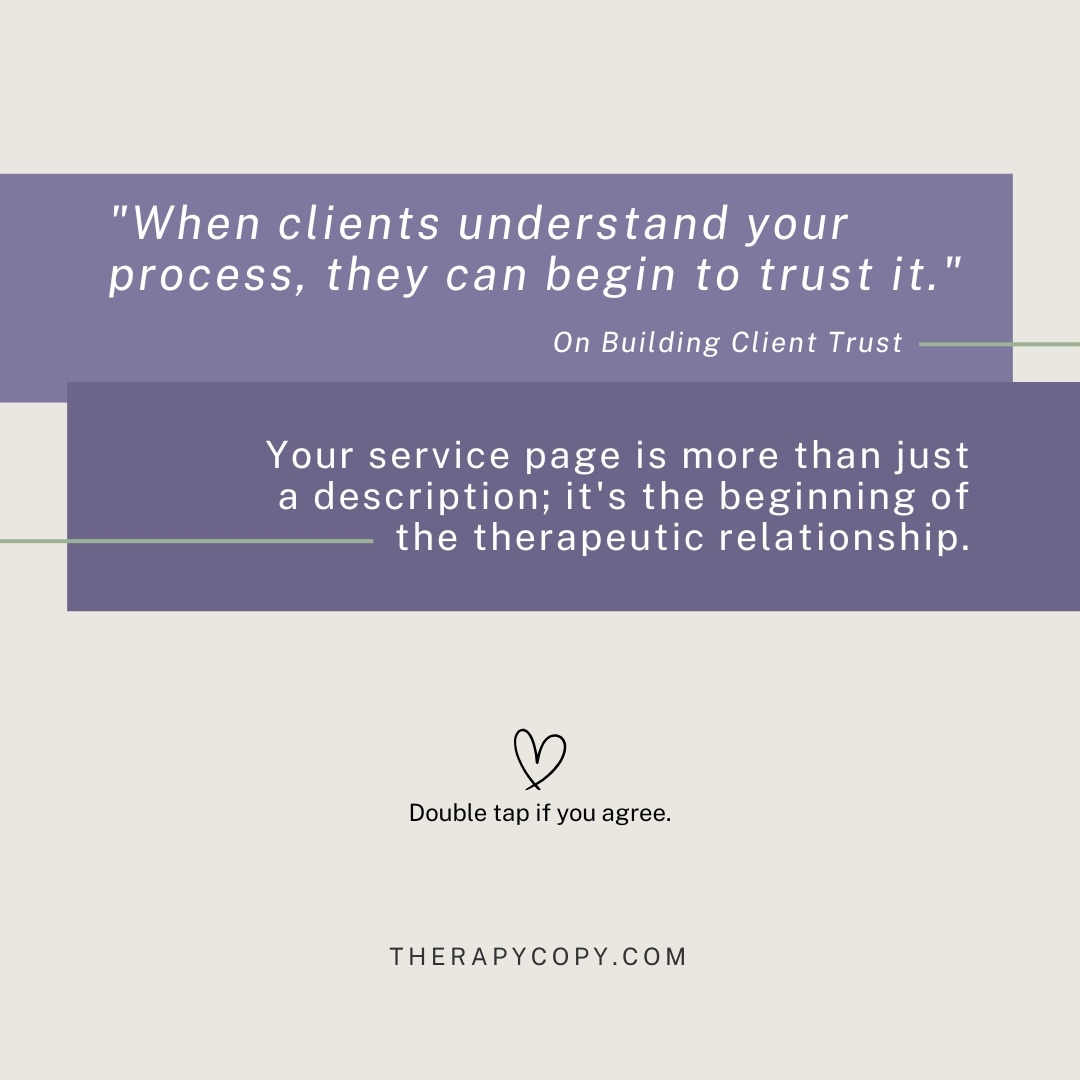Therapy Service Pages: How to Explain What You Do and How You Do It
If you’ve read my blogs about the difference between specialty and service pages and all about specialty pages, you are ready to tackle your service pages.
Especially after writing the rest of your website, service pages can be a bit of a mindset shift. You are taking the really technical aspects of what you do and translating them in a way that your clients can understand.
Doing your best to help your prospective clients see the benefits of the therapy you do without making unreasonable promises. Most of all, you are trying to continue to connect with them.
Your goal for this page is to talk about what you do and how you do it in language that connects.
Just like when you are writing your specialty pages, you already know what your clients need to hear. You also know from clients who have completed treatment that the benefits that clients appreciate the most.
You know how to help them feel understood, and you are an expert in the services that you provide.
But how do you explain it in a way that isn’t clinical and doesn’t feel elitist?
How do you talk to them without seeming unprofessional?
How do you talk about what is possible without making promises the client might not experience?
Read on, and I’ll help you write your first service page.
Connection: What your Website and Service Pages are All About
Service pages are a little different because instead of focusing on letting your specialty population know that you understand them and can help them, you are showing these same clients that you know how to help them.
But you still need to focus on that connection piece. So you translate the features of your therapy style/modality or what you offer into the benefits or how it helps them.
You want to show them how your therapeutic modality helps them achieve the results they are hoping for. So you’re still talking about pain points and hopes, but in a way that talks about the client's secret wants and needs.
Here’s an example: pretend you’re an EMDR therapist who focuses on trauma. On your specialty page, you would talk about your client's pain points, how therapy with you is different, and how it will help them (for more info about specialty pages, check out my blog here).
So you would talk about waking up with nightmares, never feeling good enough, and always feeling like people will abandon you on your specialty page.
On the other hand, your service page also covers some of this, but in relation to how EMDR helps with these symptoms. Here’s a sample of what that would look like: “Through specialized eye movements, we will reprocess the traumatic memories you have from childhood and change how you think about yourself.”
Let’s dive more deeply into the specifics of what a service page is.
Your Service Page: The How instead of Why
Your service page is a description of how working with you will help your ideal clients get better. Where your specialty page tells them, “I understand what it’s like to struggle with depression,” your service page says, “This is how I help with depression.”
Your service page is where you explain the techniques and approaches you use. By explaining what they look like and the benefits they will receive in terms they will understand. Without getting stuck in the weeds.
Your service page answers the question of how you will help me get better. You discuss the details of what sessions look like and how they will help. But you need to stay casual and connected, not clinical and detached.
Here is an example; instead of saying “I use Accelerated Resolution Therapy to help you heal from the traumatic experiences that have been keeping you stuck.” you would want to say something like “Using targeted eye movements we will create new associations with your traumatic memories, helping you to move forward without the pain that you experienced before.”
Your ideal clients don’t care about the technical name of what you do as much as they care about how it will help them.
The only time they care about the technical name is if someone has sent them to find a certain type of therapy. So, if you do a modality of therapy that is highly sought after, make sure it’s in your title and some headers. Other than that, you are looking to provide hope and a clear path towards healing.
The job of your service page is to show them that path while continuing to speak their language.
You want to translate what you do into the benefits that matter to your clients.
How will your modality change their life?
How will they feel better?
What is possible with this modality of therapy?
Remember that you want to be as transparent as possible. Your service page answers these questions while continuing to build trust and connect with your ideal client.
What is the Purpose of a Service Page
There are many purposes to your service pages, but the overall goal is that you are still building a connection with your ideal client and helping to build trust. This builds comfort so your perfect-fit client will reach out for a consultation. Here are some of the smaller goals you are trying to achieve with your service pages;
Build Trust Through Clarity
When future clients can see what you do and what therapy with you looks like, it makes it easier to reach out. It relieves the fear of the unknown. This relief provides a feeling of safety for your clients before they even contact you. If they can see that you have a plan and that you know what you are doing when it comes to helping people struggling in the same way that they are.
Answer Questions They Are Afraid to Ask or Don’t Know They Have
Your service page serves to answer questions and put your clients at ease before the consultation and between the consultation and the first session. By addressing these questions before they come up, you show clients you understand where they are and what they need. This builds more expertise and trust.
Set Appropriate Expectations Before They Start
One of the most important parts of your service page is that it helps set realistic expectations about therapy. It helps clients understand what their path to healing realistically will look like and what they can expect from themselves and you through the process. This sets the foundation for a trusting therapeutic relationship where you both know from the start if the other is a good fit.
Setting Up The Path to Healing
Your service page is just one stop on their path to healing, but it helps them learn about how to get started and move forward. It should have a clear explanation of what the next steps are and how to take those steps.
When clients understand what you do and how it helps, they feel more comfortable taking those steps. It makes gray areas more concrete, and when you follow through with the process, it instantly builds trust.
Service Page Specifics: What Sections to Include
Now that we understand what a service page is and what it’s for, let’s discuss the sections you should include. We’re still doing what we can to connect with your ideal clients while giving them the information they need to decide if you are the right fit.
Description of Your Therapy Approach
Start off by explaining your therapeutic approach or modality in everyday language. This is where you translate the clinical terms into the words your clients will actually use.
Instead of saying “I use an attachment-based approach,” you might say “ I help you understand how your childhood experiences are shaping your current relationships.”
You want to focus on how the approach feels to the client. What will they experience? How is this different from other approaches? What benefits will they experience that are different from other approaches they have tried?
Make sure to name any specific modality that clients might be searching for (like EMDR, IFS, or CBT). Name it clearly and then explain it in client-friendly terms.
Make sure that you also explain your specific take on this therapy modality so that they can make an educated decision between you and other therapists out there who do the same thing.
Who Does This Approach Help
This section connects your approach to the struggles your ideal clients face (discussed in your specialty pages). You are showing the direct connection between your client's struggles on your specialty page and your solution, i.e., your approach. Name symptoms in their language and what they might be experiencing.
An example, “This approach is helpful if you are still impacted by traumatic incidents that happened in your past. If they wake you up at night, or you notice that your body is always tense. It was created to help people with this type of trauma.”
Be specific about what symptoms or issues your approach is most effective with and what it isn’t effective with. This helps clients self-identify whether your services are right for them.
The Process and What to Expect
Your clients, especially if they are new to therapy, want to know what happens in therapy with you. This section helps them feel more comfortable by pulling back the curtain.
Explain what a typical session looks like, and all of the details around that.
Clients want to know what therapy is like. They want to know what the tone you set in the room will be like. This section removes the mystery and helps them feel more comfortable taking that first step.
Here, you want to describe a regular session so they know what to expect.
Describe realistic benefits and outcomes
This is where you explain the possibilities. Make sure that you are giving them hope, but also being realistic about what your clients actually experience as a result of your therapy modality.
Talk about the results you see in the short and long term. You can include generalities about what clients experience.
Be careful not to make promises or guarantees. Don’t use all-or-nothing language like all of my clients experience…. Or my clients no longer experience…..
Practical Details
Make sure you have a section that gives all of the specifics about how you do therapy. Include things like:
Session length
Typical frequency of sessions
In-person vs. virtual options
Fees and insurance information
Cancellation policies
This information helps clients decide if they are ready to take on the work that goes into therapy.
Call To Action
Just like with your other pages, it’s important for your ideal clients to know where to go next. How do they take the next step and move forward towards working with you?
Make sure you have a way for them to schedule and contact you that is easy to find. It’s important that they don’t have to search for very long.
Your service page should feel like a natural extension of your specialty page. Basically it’s an extension of the information about how you work with your specialty.
Keeping it Warm and Casual
One of the hardest parts of writing their website for many therapists is talking about professional topics in normal everyday language. But that’s what you want to do. You want to write your service page and the rest of your website like you are talking to a client.
Use the words that you would say verbally to a client.
Describe what you do in the way that you talk about it at dinner with family or on a consultation call.
Your website is a conversation with your ideal client who is in pain and desperately searching for help. Put aside the professional jargon we were all taught and help your clients understand who you are.
Often, technical jargon creates distance and makes clients feel like you are better than them. Using the warm, casual language you use in session helps your clients feel seen.
Before you publish your page, read it out loud. Does it sound like you? Is this how you would speak to a client? If not, keep editing.
Don’t be afraid to show parts of your personality. That is what is going to help your clients find you as their best-fit therapist.
Do you need help with your website?
Writing website copy that captures who you are and what you do isn’t easy, even with this blog in hand. As both a therapist and copywriter, I understand how hard it can be to translate your expertise into language that feels authentic to you.
If you’re feeling stuck, I’m here to help. My done-for-you copywriting service takes the pressure off while creating content that deeply connects with your ideal-fit clients.
As someone who already deeply understands what you do, I get to know you and your practice so that I can write or help you write copy that is authentic to who you are and what you do.
If you are ready to have a website that genuinely connects with the clients you serve best? Schedule a consultation today.


